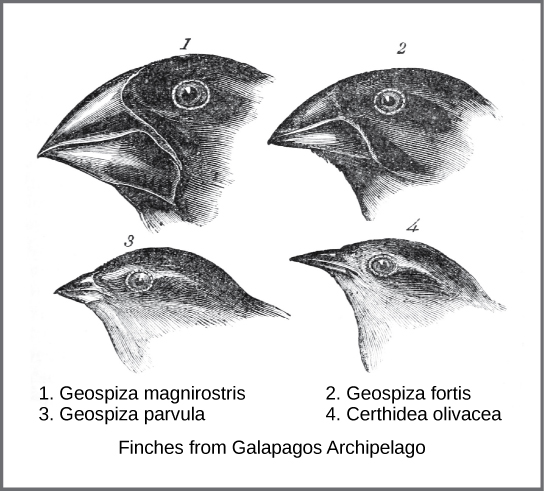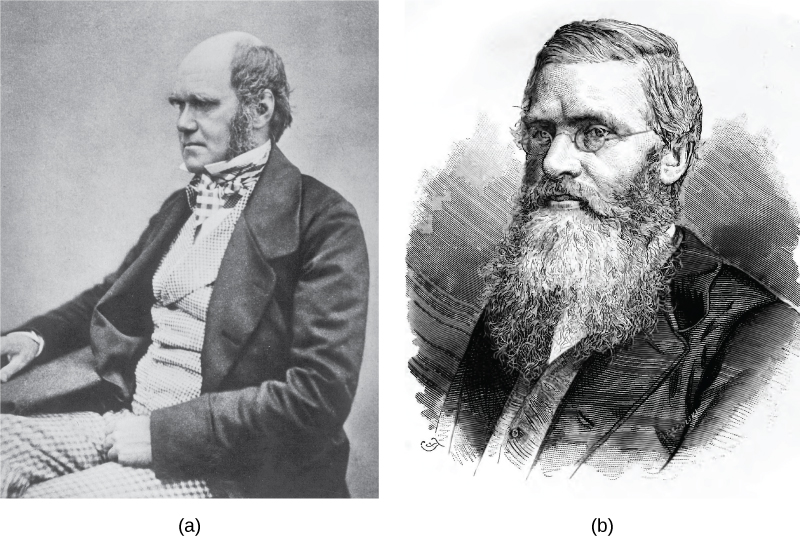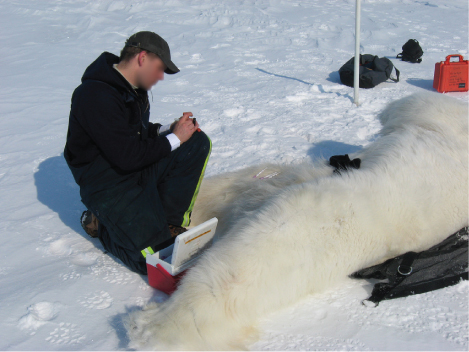explain what it means to say that natural selection is not random
23 Charles Darwin and Natural Choice
In the mid-nineteenth century, two naturalists, Charles Darwin and Alfred Russel Wallace, independently conceived and described the actual mechanism for evolution. Importantly, each naturalist spent time exploring the natural world on expeditions to the torrid zone. From 1831 to 1836, Darwin traveled around the world on H.M.South. Beagle, including stops in Southward America, Commonwealth of australia, and the southern tip of Africa. Wallace traveled to Brazil to collect insects in the Amazon rainforest from 1848 to 1852 and to the Malay Archipelago from 1854 to 1862. Darwin's journeying, similar Wallace's later journeys to the Malay Archipelago, included stops at several island chains, the last existence the Galápagos Islands west of Ecuador. On these islands, Darwin observed species of organisms on unlike islands that were clearly like, yet had distinct differences. For example, the ground finches inhabiting the Galápagos Islands comprised several species with a unique beak shape (Effigy 1).
The species on the islands had a graded series of nib sizes and shapes with very modest differences between the most similar. He observed that these finches closely resembled another finch species on the Southward American mainland. Darwin imagined that the island species might be species modified from 1 of the original mainland species. Upon farther written report, he realized that each finch'southward varied beaks helped the birds acquire a specific blazon of food. For example, seed-eating finches had stronger, thicker beaks for breaking seeds, and insect-eating finches had spear-similar beaks for stabbing their casualty.

Wallace and Darwin both observed similar patterns in other organisms and they independently developed the aforementioned explanation for how and why such changes could accept identify. Darwin chosen this machinery natural selection. Natural selection, or "survival of the fittest," is the more than prolific reproduction of individuals with favorable traits that survive environmental change because of those traits. This leads to evolutionary change.
For example, Darwin observed a population of giant tortoises in the Galápagos Archipelago to take longer necks than those that lived on other islands with dry lowlands. These tortoises were "selected" considering they could reach more leaves and access more food than those with short necks. In times of drought when fewer leaves would exist available, those that could reach more leaves had a better chance to eat and survive than those that couldn't reach the food source. Consequently, long-necked tortoises would exist more likely to exist reproductively successful and laissez passer the long-necked trait to their offspring. Over fourth dimension, just long-necked tortoises would exist present in the population.
Natural selection, Darwin argued, was an inevitable outcome of 3 principles that operated in nature. Beginning, most characteristics of organisms are inherited, or passed from parent to offspring. Although no one, including Darwin and Wallace, knew how this happened at the time, it was a common understanding. Second, more offspring are produced than are able to survive, so resources for survival and reproduction are limited. The chapters for reproduction in all organisms outstrips the availability of resources to support their numbers. Thus, there is competition for those resources in each generation. Both Darwin and Wallace's understanding of this principle came from reading economist Thomas Malthus' essay that explained this principle in relation to human populations. Third, offspring vary amongst each other in regard to their characteristics and those variations are inherited. Darwin and Wallace reasoned that offspring with inherited characteristics which permit them to best compete for limited resource will survive and have more offspring than those individuals with variations that are less able to compete. Considering characteristics are inherited, these traits will exist better represented in the adjacent generation. This will lead to change in populations over generations in a process that Darwin called descent with modification. Ultimately, natural choice leads to greater adaptation of the population to its local environment. Information technology is the only mechanism known for adaptive development.
In 1858, Darwin and Wallace (Figure 2) presented papers at the Linnean Lodge in London that discussed the idea of natural choice. The post-obit year Darwin's book, On the Origin of Species, was published. His book outlined in considerable detail his arguments for evolution by natural selection.

It is difficult and time-consuming to certificate and present examples of development past natural choice. The Galápagos finches are an first-class instance. Peter and Rosemary Grant and their colleagues take studied Galápagos finch populations every year since 1976 and take provided important evidence of natural selection. The Grants found changes from i generation to the adjacent in bill shape distribution with the medium ground finch on the Galápagos island of Daphne Major. The birds take inherited a variation in their bill shape with some having wide deep bills and others having thinner bills. During a period in which rainfall was college than normal because of an El Niño, there was a lack of big difficult seeds of which the big-billed birds ate; however, there was an affluence of the small soft seeds which the small-scale-billed birds ate. Therefore, the minor-billed birds were able to survive and reproduce. In the years following this El Niño, the Grants measured nib sizes in the population and establish that the average bill size was smaller. Since bill size is an inherited trait, parents with smaller bills had more offspring and the pecker evolved into a much smaller size. Equally conditions improved in 1987 and larger seeds became more than available, the trend toward smaller average nib size ceased.
CAREER Connection
Field Biologist
Many people hike, explore caves, scuba dive, or climb mountains for recreation. People often participate in these activities hoping to meet wild animals. Experiencing the outdoors can be incredibly enjoyable and invigorating. What if your chore entailed working in the wilderness? Field biologists by definition work outdoors in the "field." The term field in this instance refers to any location outdoors, even nether water. A field biologist typically focuses enquiry on a certain species, grouping of organisms, or a unmarried habitat (Effigy 3).

One objective of many field biologists includes discovering new, unrecorded species. Not only do such findings expand our understanding of the natural world, but they likewise lead to of import innovations in fields such as medicine and agriculture. Plant and microbial species, in particular, tin reveal new medicinal and nutritive noesis. Other organisms can play primal roles in ecosystems or if rare crave protection. When discovered, researchers tin employ these important species as evidence for environmental regulations and laws.
Access for free at https://openstax.org/books/biology-2e/pages/1-introduction
Source: https://pressbooks.umn.edu/introbio/chapter/darwin/
0 Response to "explain what it means to say that natural selection is not random"
Post a Comment